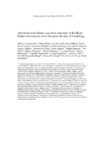Mostrar o rexistro simple do ítem
Advanced heart failure: a position statement of the Heart Failure Association of the European Society of Cardiology
| dc.contributor.author | Crespo-Leiro, María Generosa | |
| dc.contributor.author | Metra, Marco | |
| dc.contributor.author | Lund, Lars H. | |
| dc.contributor.author | Milicic, Davor | |
| dc.contributor.author | Costanzo, Maria Rosa | |
| dc.contributor.author | Filippatos, Gerasimos | |
| dc.contributor.author | Gustafsson, Finn | |
| dc.contributor.author | Tsui, Steven | |
| dc.contributor.author | Barge-Caballero, Eduardo | |
| dc.contributor.author | De Jonge, Nicolaas | |
| dc.contributor.author | Frigerio, Maria | |
| dc.contributor.author | Hamdan, Righab | |
| dc.contributor.author | Hasin, Tal | |
| dc.contributor.author | Hülsmann, Martin | |
| dc.contributor.author | Nalbantgil, Sanem | |
| dc.contributor.author | Potena, Luciano | |
| dc.contributor.author | Bauersachs, Johann | |
| dc.contributor.author | Gkouziouta, Aggeliki | |
| dc.contributor.author | Ruhparwar, Arjang | |
| dc.contributor.author | Ristic, A.D. | |
| dc.contributor.author | Straburzynska-Migaj, Ewa | |
| dc.contributor.author | McDonagh, Theresa | |
| dc.contributor.author | Seferovic, Petar M. | |
| dc.contributor.author | Ruschitzka, Frank | |
| dc.date.accessioned | 2019-02-21T08:22:43Z | |
| dc.date.issued | 2018-05-27 | |
| dc.identifier.citation | Crespo-Leiro MG, Metra M, Lund LH, et al. Advanced heart failure: a position statement of the Heart Failure Association of the European Society of Cardiology. Eur J Heart Fail. 2018; 20(11): 1505-1535 | es_ES |
| dc.identifier.issn | 1388-9842 | |
| dc.identifier.uri | http://hdl.handle.net/2183/21898 | |
| dc.description.abstract | [Abstract] This article updates the Heart Failure Association of the European Society of Cardiology (ESC) 2007 classification of advanced heart failure and describes new diagnostic and treatment options for these patients. Recognizing the patient with advanced heart failure is critical to facilitate timely referral to advanced heart failure centres. Unplanned visits for heart failure decompensation, malignant arrhythmias, co‐morbidities, and the 2016 ESC guidelines criteria for the diagnosis of heart failure with preserved ejection fraction are included in this updated definition. Standard treatment is, by definition, insufficient in these patients. Inotropic therapy may be used as a bridge strategy, but it is only a palliative measure when used on its own, because of the lack of outcomes data. Major progress has occurred with short‐term mechanical circulatory support devices for immediate management of cardiogenic shock and long‐term mechanical circulatory support for either a bridge to transplantation or as destination therapy. Heart transplantation remains the treatment of choice for patients without contraindications. Some patients will not be candidates for advanced heart failure therapies. For these patients, who are often elderly with multiple co‐morbidities, management of advanced heart failure to reduce symptoms and improve quality of life should be emphasized. Robust evidence from prospective studies is lacking for most therapies for advanced heart failure. There is an urgent need to develop evidence‐based treatment algorithms to prolong life when possible and in accordance with patient preferences, increase life quality, and reduce the burden of hospitalization in this vulnerable patient population. | es_ES |
| dc.language.iso | eng | es_ES |
| dc.publisher | Wiley | es_ES |
| dc.relation.uri | https://doi.org/10.1002/ejhf.1236 | es_ES |
| dc.rights | This is the peer reviewed version of the article which has been published in final form at Wiley Online LIbrary. This article may be used for non-commercial purposes in accordance with Wiley Terms and Conditions for self-archiving. | es_ES |
| dc.subject | Heart failure | es_ES |
| dc.subject | Heart transplantation | es_ES |
| dc.subject | Heart-assist devices | es_ES |
| dc.subject | Extracorporal membrane oxigenation | es_ES |
| dc.title | Advanced heart failure: a position statement of the Heart Failure Association of the European Society of Cardiology | es_ES |
| dc.type | info:eu-repo/semantics/article | es_ES |
| dc.rights.access | info:eu-repo/semantics/embargoedAccess | es_ES |
| dc.date.embargoEndDate | 2019-05-27 | es_ES |
| dc.date.embargoLift | 2019-05-27 | |
| UDC.journalTitle | European Journal of Heart Failure | es_ES |
| UDC.volume | 20 | es_ES |
| UDC.issue | 11 | es_ES |
| UDC.startPage | 1505 | es_ES |
| UDC.endPage | 1535 | es_ES |
Ficheiros no ítem
Este ítem aparece na(s) seguinte(s) colección(s)
-
INIBIC-ICATC - Artigos [177]






